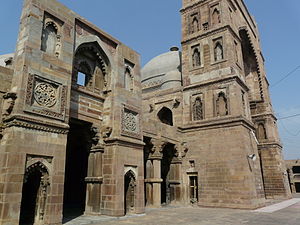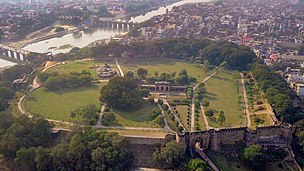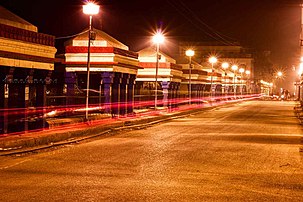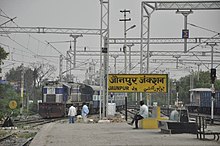Jaunpur district
Jaunpur | |
|---|---|
Machhlishahr | |
| • Member of Parliament, Lok Sabha | Shyam Singh Yadav |
| Area | |
| • Total | 4,038 km2 (1,559 sq mi) |
| Population (2011) | |
| • Total | 4,494,204 |
| • Density | 1,100/km2 (2,900/sq mi) |
| • Urban | 346,580 |
| Demographics | |
| • Literacy | 73.66% |
| • Sex ratio | 1018 |
| • Language | Hindi • Urdu |
| Time zone | UTC+05:30 (IST) |
| Vehicle registration | UP-62 |
| Average annual precipitation | 1098 mm |
| Website | Official Website |
Jaunpur district is a
Geography

The district of Jaunpur is situated in the northwest part of
Rivers
Climate
Jaunpur district has a climate consistent with that of the Northern Plain and Central Highlands including the
Topography
The topography of the district is a flat plain undulating with shallow river valleys. The main permanently flowing rivers are the Gomti and the Sai.[4] The rivers of Jaunpur flow from northwest to southeast and the land slopes in the same direction. Thus, there is a more elevated area in the northwest and a less elevated area of land in the southeast.[5]
Geology
Beneath the surface of the district of Jaunpur, is a thick
Demographics
| Year | Pop. | ±% p.a. |
|---|---|---|
| 1901 | 1,201,667 | — |
| 1911 | 1,155,244 | −0.39% |
| 1921 | 1,153,633 | −0.01% |
| 1931 | 1,234,365 | +0.68% |
| 1941 | 1,385,490 | +1.16% |
| 1951 | 1,515,043 | +0.90% |
| 1961 | 1,727,264 | +1.32% |
| 1971 | 2,005,434 | +1.50% |
| 1981 | 2,532,734 | +2.36% |
| 1991 | 3,214,636 | +2.41% |
| 2001 | 3,911,679 | +1.98% |
| 2011 | 4,494,204 | +1.40% |
| source:[6] | ||
In 2011, an official census was made in Jaunpur district. It recorded a population of 4,494,204 of which 2,258,437 were female and 2,217,635 male making it 7th most populated district in whole state.[8] Jaunpur district has population density of 1,113 persons per km2. Between 2001 and 2011, the population of Jaunpur district grew 14.89%. Literacy increased from 59.84 to 73.66 percent. In 2011, 86.06 percent of men were literate and 61.7 percent of women. Children under six years formed 14.37% of the population. 7.71% of the population lives in urban areas. Scheduled Castes made up 22.04% of the population.[8]
Jaunpur ranks seventh in terms of population in the state and ranks first in terms of sex ratio (1,024). There are 663,513 households in the district accounting for 2% of the total households in the U.P. The average size of households in the district is 6.8 persons. Urban population in the district is only 7.7% of total population.[8]
Languages
At the time of the
Governance
Divisions
Within the district, there are two national lower house constituencies,
Tahsils
Development Blocks
Jaunpur district is further divided into twenty-one "development blocks".
Thanas
There are also twenty-six police districts (Thanas).
- Kotwali
- Sadar
- Line Bazar
- Zafarabad
- KhetaSarai
- Shahganj
- Sarpatahan
- Kerakat
- Chandwak
- Jalalpur
- Sarai Khwaja
- Gaura Badshahpur
- Badlapur
- Khuthan
- Singra
- Baksha
- Sujanganj
- Maharajganj
- Mungra Badshahpur
- Pawara
- Machhlishahr
- Meerganj
- Sikrara
- Mariahu
- Rampur
- Barsathi
- Nevadhiya
- Sureri
- Baserawan
- Kaserawan
- Janghai
Economy
The district's main economical activity is agriculture and allied sector. Jaunpur is the fastest developing area in eastern Uttar Pradesh with skill development, quality education and good infrastructure.
Agriculture
The main field crops of Jaunpur district are: rice, maize, pigeon pea, pearl millet, blackgram wheat and chickpea. Other crops are onion and potato and crops for
Industry
There is little heavy industry in Jaunpur. The Varanasi Jaunpur highway allows for some industrial economic development. A cotton mill was operational near Karanja Kala but has now been replaced by a medical college and there are some textile manufacturers. Other manufactured products include perfume (jasmine oil and attar) and incense, furniture, carpets, chemical fertiliser and cement. Tertiary and service industries include repair workshops, print shops and internet cafes.[4][10][11][12] There is a special economical zone located at Allahabad road near Mungra Badshahpur the Sathariya Industrial area or SIDA. Jaunpur has a problem of poor infrastructure development. Like many other districts of eastern Uttar Pradesh, Jaunpur has poor road quality and a lack of electricity supply. National highway number 56 between Lucknow and Varanasi cross from Jaunpur.
Agro-park in Varanasi near Babatpur airport on Varanasi-Jaunpur highway is said to boost the food-processing industry in the region.[13]
Tourist destinations
| Part of a series on the |
| Jaunpur Sultanate سلطنت جونپور |
|---|
 |
Atala Masjid

Firoz Shah III began the construction of the
Jhanjhari Masjid
The Jhanjhari Masjid, on the north bank of the Gomti river, was built by Ibrahim in the Sipah locality of Jaunpur township. It was a residence of Ibrahim himself, as well as a place for saints, scholars (
Lal Darwaza Masjid
This Masjid was built in 1447 (as per inscription of this masjid) at
Masjid Jama ash Sharq (Jama Masjid)

The
.Raja Ki Haveli

It is situated on Panchatiya Road. The palace of royal family of Jaunpur was once owned by Raja Yadvendra Dutt Dubey. Now the palace has been converted into Wedding Lawn. The palace also has a Pokhra where events like Ravan Dahan and Dussehra mela takes place every year.
Shahi Qila
In 1462, Firoz Shah III built the
The main gates face east. The largest inner gate is 14 metres (46 ft) in height. Its external surface is set with

The mosque or masjid is likely the oldest building in Jaunpur township. It was a simple
Shahi Pul

The
Sheetla Chowkiya Dham
Located at Chowkiya, Panchhatiya, the temple is devoted to goddess Shitala, who resides in the main temple of the complex. There are other temples of god and goddess of mostly of the local deities. There is also a pond.The temple is very much popular among the locals. It is believed that before leaving the district, it's necessary to take blessings of Mata Sheetla for safety and well-being. There is a Neem tree in temple believed to be more than 300 years old.
Transport
Roadways
Jaunpur is well-connected to
etc. Mariahu NH-56, SH-36 are the roadways connecting all major cities to Jaunpur. The major bus stations are in Jaunpur city and Machhlishahr. Road dividers are also being built to avoid traffic jams.Railways
Jaunpur is well-connected with all major cities of India thanks to




Following is the list of all junctions and halt stations in Jaunpur Districts:
- Jaunpur Junction
- Shahganj Junction
- Zafrabad Junction
- Janghai Junction
- Jaunpur City
- Mahagava Halt
- Mehrava
- Mani Kalan Halt
- Kheta Sarai
- Yadavendranagar
- Muftiganj
- Gangauli
- Kerakat
- Dobhi
- Daudhondha
- Sirkoni
- Jalalganj
- Trilochan
- Baksha
- Sarai Harkhu
- Shri Krishna Nagar
- Harpalganj
- Salakhpur
- Mariyahu
- Bhannor
- Barsathi
- Jarauna
- Nibhapur
- Badshahpur
Airways

The nearest airport is Lal Bahadur Shastri Airport in Varanasi, which is roughly 39 km (24 mi) from the city. The other nearest airport to Jaunpur is in Prayagraj which is roughly 142 km (88 mi) away.
Notable people
- Dinesh Kunwar Patel, developer of world's first homemade humanoid Robot "Shalu" that can speak 47 languages (from Rajamalpur village in Mariahu, Jaunpur)[19]
- script writer in Bollywood. Creator of the famous detective character Byomkesh Bakshi and also huge number of historical fiction novels and short stories in Bengali language.
- Ashok Bhushan - Judge at the Supreme Court of India and was 31st Chief Justice of Kerala High Court
- Mazahir Uloom, Saharanpur.
- Ravi Kishan - Actor and MP
- Mohammad Akram Nadwi- Dean faculty of Islamic studies Oxford University London
- Acharya Ramamurti - Indian social activist (Gandhian) and educationist
- Rambhadracharya - Hindu spiritual leader, poet, commentator, educationist, religious and social figure
- Indu Prakash Singh - Philosopher, economist, politician and former diplomat with the Indian Foreign Service
- Justice Surendra Kumar Yadav Special Judge in Demolition of the Babri Masjid case[20]
- Tufani Saroj - Former Member of Parliament Machhlishahr
- Lalji Singh - Scientist who worked in the field of DNA fingerprinting technology
- Rajesh Vivek - Actor
- Jagmohan Yadav - Former IPS police officer and former Director-General of Uttar Pradesh Police
- Parasnath Yadava- Former MP and former Cabinet minister of Uttar Pradesh Government
- Shailendra Yadav Lalai - MLA Shahganj and former minister of Uttar Pradesh Government
References
- ^ "Jaunpur: About". jaunpur.nic.in. Archived from the original on 8 July 2015. Retrieved 16 March 2022.
- ^ National Informatics Centre "Jaunpur official website." Government of India. Accessed 3 December 2013.
- ^ a b "Agricultural contingency plan for Jaunpur." Government of India. November 2013. Accessed 3 December 2013.
- ^ a b Ministry of Micro, Small and Medium enterprises "A brief industrial profile of Jaunpur district." Archived 3 March 2016 at the Wayback Machine Government of India. Date not stated. Accessed 3 December 2013.
- ^ a b Prasad G. "Progress in Nanotechnology." Discovery Publishing House. 2008. Vol 2. pp 68-71. Accessed at Google Books 4 December 2013.
- ^ Decadal Variation In Population Since 1901
- ^ "Table C-01 Population by Religion: Uttar Pradesh". censusindia.gov.in. Registrar General and Census Commissioner of India. 2011.
- ^ a b c "District Census Handbook: Jaunpur" (PDF). censusindia.gov.in. Registrar General and Census Commissioner of India. 2011.
- ^ a b "Table C-16 Population by Mother Tongue: Uttar Pradesh". www.censusindia.gov.in. Registrar General and Census Commissioner of India.
- ISBN 8187780045, 9788187780045 p 182. Accessed at Google Books, 6 December 2013.
- ^ Ram R. "Agricultural development: command area approach." Abhinav publications 1993. p88. Accessed at Google Books 4 December 2013.
- ISBN 8128400673, 9788128400674. p248. Accessed at Google Books 6 December 2013.
- ^ "Agro Parks, Lucknow and Varanasi | NRI Department, Government of Uttar Pradesh". upnri.com. Retrieved 9 June 2019.
- ISBN 978-81-7017-209-3.
- ^ a b "Atala Masjid" Jaunpur City website. Accessed 5 May 2012
- ^ a b c "Jaunpur Fort," Archived 7 February 2014 at the Wayback Machine Archaeological Survey of India website. Accessed 7 December 2013.
- ^ Yasin M. and Yasin M. (Ed.)"Reading in Indian History." Atlantic Publishers & Distributors, 1988. p66. Accessed at Google Books 6 December 2013.
- ISBN 0521267285, 9780521267281. p88 Accessed at Google Books 6 December 2013. Akriti Shukla(Gupta ji).
- ^ Javed Ahmed (24 March 2021). "जौनपुर के दिनेश पटेल ने बनाया अर्द्ध मानव रोबोट, 9 भारतीय, 38 विदेशी भाषाओं में कर सकता है संवाद". ABP News. Retrieved 22 October 2021.
- ^ "सुरेंद्र कुमार यादव: बाबरी पर फ़ैसले से यूपी के उप लोकायुक्त तक". BBC News हिंदी (in Hindi). 13 April 2021. Retrieved 16 March 2023.
